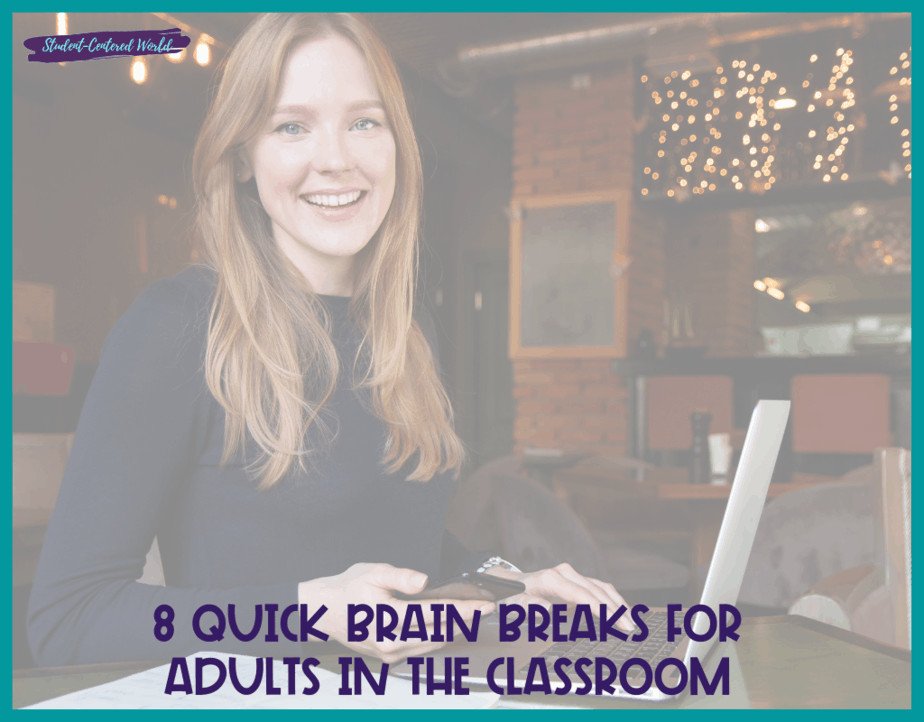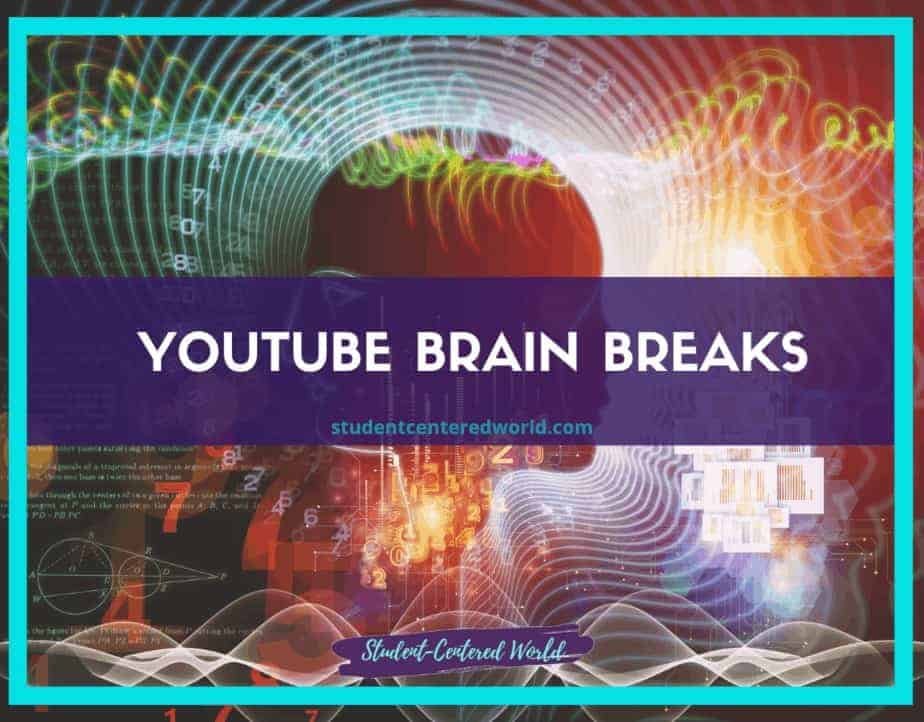8 Quick Brain Breaks for Adults in the Classroom
If you’ve been following our series about brain breaks in the classroom you will know how important we find them to our students. In this day and age, it’s absolutely vital to make sure that we are giving our students time to collect themselves so they are able to focus and perform better in the classroom. However, it is also important to reflect on the importance of brain breaks for adults in the classroom, too.
We know our students are not like previous generations and are physically different which makes it more difficult for them to concentrate and focus.
As the adults in the room, we need to make sure that we recognize this and that we are giving them the opportunities to learn and police themselves when it comes to what their own bodies need in order to be able to perform their best in the classroom. But what about us? What about brain breaks for adults?
While we’re worrying about the students, we need to be worrying about ourselves as well. As Educators, in general, we have a tendency to put ourselves last on the priority list.
But what about us?
Sometimes we need a few minutes to collect ourselves too, but in a profession where you have just minutes a day to use the bathroom, how are we supposed to be able to take brain breaks when we need them the most? How many of us can honestly say that we sit down and have a full lunch every day where we can just decompress?
It might happen sometimes, but it’s very rare to do that consistently.
We also need a few minutes here and there throughout the day to make sure that we are performing at our best. Brain breaks for adults shouldn’t take a back seat to everything else. Not only are they important for our own mental health, but they’re important to make sure that we are on top of our game for our students.
They deserve that…and so do we.
(This post may contain affiliate links that won’t change your price but will share some commission. As an Amazon Associate, I earn from qualifying purchases. Please read our disclosure policy for more information.)
Changing the Classroom to Help Your Own Sanity
The easiest and most consistent way to do this for ourselves is to create a truly student-centered environment in our classroom. With the students being hands-on and us taking the role as facilitators and one-on-one helpers, it makes it easier to take a moment or two on the side of the room while students are working, without them being any of the wiser that we’re doing it.
They’re still working hard, and it gives us the opportunity that we may need to make sure that we are on point. We’re still very active in the classroom and our interactions with our students in this environment are more important than ever, but it lends itself to be able to make sure that they are getting what they need to out of the activity and we are also getting what we need to out of that moment.
So what can we do during these moments (ad) that allow us to be able to collect ourselves without it being obvious to our students?
Honestly just like we need to do what’s best for our students as individuals, we also need to do what’s best for us. You are the only person that truly knows what can get you level. It might be doodling, it might be having a few sips of coffee, it might be reading an article that interests you. You might take a few laps around the classroom, or if you have something fun like a coloring bulletin board you can take a moment and participate in that (which your students would love to watch you do).
You also have the option when you need brain breaks for adults to have a full class brain break. There’s nothing saying that you can’t also participate in some of the activities that you have planned for your students (have you checked out Brain Break Bingo?). Maybe you need to be just as silly as they are in order to get together.
If it’s more clerical, take 2 minutes and respond to an email that you have been watching in your inbox. Getting something like that crossed off your to-do list may be enough to help keep you grounded.
Taking the Lead as the Adult in the Room
We always say that we want student buy-in, but often we need to remember that we need to lead by example. There’s nothing wrong with participating in what they are doing.
Brain breaks for adults don’t have to be all “grown-up”.
We don’t have to necessarily be actively monitoring every single thing that’s going on in our classrooms. If they see us participating, they’re more apt to do the same.
Teach them some yoga poses (which helps you AND them on a number of levels). Play a game and try to make it competitive. See who can do it better, you or them.
Obviously, this is not appropriate for every activity that’s going on in your classroom, but again you have to figure out what’s going to work best for you.
Go out on a limb and just try something, it might be wildly successful or it might not work out and you know next time either tweak it or try something different.
One concern with this is always what about if you end up having an observation at that exact moment. There’s nothing worse than when you sit down at your desk for the first time all day to do something quickly at your computer and your administrator walks in.
We’ve all been there and can agree it’s the worst.
But beyond that, if you’re engaging in something else, it shows that you are in tune with what your students are doing (or need at that moment) and that is what your administrator wants to see.

As long as you can show that what you’re doing is important to the well-being of your students, then that is the most important part. That is a huge part of an observation rubric. If you can show that a brain break will help your students participate and focus even better (and you don’t have to mention you are partaking in one yourself), it shows that you have a handle on what’s going on in your classroom.
Bonus points if you can get the administrator to join in as well. Now that creates some serious student buy-in!
It’s literally just important to take brain breaks for adults as it is for a student. We know our peers in other fields can run out for a cup of coffee or converse with a colleague whenever they need a moment to do so.
We don’t have that luxury as a teacher, and our opportunities to do activities like this are a very small part of our day. But we need to make sure that we give ourselves opportunities 2 destress or get energized, whether this is before class starts, during class, or once our students leave.
Sometimes we also need help with transitions just as our students do.
There is no shame in finding a way to make sure that you are being the best version of yourself as a teacher as you try to allow your students to learn how to be the best versions of themselves...and of course, the easiest way to do this is by regularly implementing brain breaks for adults.
Quick Brain Breaks for Adults
The teaching season the started in March 2020 did nothing but prove not only how valued teachers are, but how undervalued they’re viewed. Many of us were pushed to the brink (and in some cases, are still teetering there) and those who were able to tread water had one thing in common: they had external support.
But what about those of us who don’t have external support? Whose “support system” just keeps dumping expectations on us without giving us grace? This is becoming a mental health crisis and it is absolutely imperative to learn how to incorporate brain breaks for adults into our every day (often several times a day) to keep strong because if we don’t, we will eventually crumble under this enormous weight being continually added to on our shoulders.

So what brain breaks for adults can be easily implemented without skipping a beat?
1. Caffeine breaks:
If you’re a coffee drinker, take a break and go get your favorite beverage. Make sure it’s caffeinated and drink the entire cup slowly while you look around at everything in the room that is red. Why red? Studies have shown that looking at red objects can lower your heart rate and decrease anxiety.
If you aren’t a coffee drinker or just don’t like the taste of it, you can choose a caffeinated beverage that you do enjoy. Just make sure it’s something to consider in terms of brain breaks for adults to get your blood moving and give you the extra energy boost that will help get your brain working again for the rest of your day.
2. Stretch breaks:
This is an excellent one to do when you feel yourself getting stuck at a desk or in the same area for an extended period of time. It’s also great to do when you notice that your mood has begun to sour or you’re feeling anxious about something.
Stretch breaks are an opportunity to get up and move around, let your eyes refocus on objects in the distance, and give your mind time to relax. There are a number of YouTube videos out there if you would like some guidance on how to get started with really meaningful stretches to incorporate into your brain breaks for adults.
(Did you know that there are actually yoga poses that help release trauma and other internalized feelings? Check out our podcast episode with The Namaste Project to learn more).
3. Breathing breaks:
Another one of my favorite brain breaks for adults is taking time periodically throughout my day to breathe through some anxiety. A new site called headspace offers a full-length meditation web app that is free to try for 10 days, and it’s amazing! Even if you can’t get to the end of the full 10 days because your schedule gets in the way (happens to me all the time), I’d recommend giving this one a try.
4. Change of scenery:
Get away from the same block you’ve been walking for ten years, go find a new one! Take a different route to work. When you feel yourself getting worked up about something, abandoned the usual commute route to work or home and find a new one. You’ll feel like you’ve had a mini-vacation within your own city, trust me! In terms of brain breaks for adults, this may be the easiest to accomplish.

5. Pet therapy:
If you have a furry friend in your household that is not opposed to being used as a cuddle buddy, take advantage of their therapeutic presence by making them your reason for getting up each morning. It’s been proven that petting a dog or cat can help lower a person’s blood pressure and produce good feelings in your brain. This is a great way to implement brain breaks for adults once you get home (but wouldn’t it be great if we could bring our pets to work?!)
6. Listen to music:
If you have a favorite group or solo artist, listen to their songs as you work on whatever it is you need to do at the moment. If none of your favorite songs are coming to mind, open up YouTube or an online music streaming site and search for “song with lyrics that inspire me.” It’s amazing how many uplifting tunes you can find this way.
This is also an easy option to incorporate music in the classroom on the regular. I speak about the benefits of music in the classroom here. There is no requirement that you have to play music that your students choose; jam out to your own favorites (and immerse them in some tunes they might not be familiar with, too!)
7. Fidget toy breaks:
For those of us whose anxiety likes to have its hand in everything, any type of fidget toy might be helpful in distracting you from the negative thoughts that are plaguing your brain. Some options are sensory toys, stress balls, squishy things, etc. These are simple brain breaks for adults, but it really does help refocus your brain.
8. Take a moment for yourself:
Whether this means taking 5 minutes before bed each night to reflect on an amazing day or 20 minutes during work to go meditate in the bathroom, you need to find time every day to take care of yourself. This is most easily done when we teach our students; we can help them with this by offering one-on-one time and inviting them to sit outside with us during recess or before/after school. It is up to you to determine what brain breaks for adults look like though (meaning, does it include kids or not).
Stop Driving the Teacher Struggle Bus
Are you struggling with student engagement, apathy, or keeping your class on track?
💫💫 There’s hope! 💫💫
Join my free teacher workshop “Choosing Choice” and in just 60 minutes, you’ll craft a practical plan to revitalize your teaching. Discover the magic of student choice in boosting engagement, gain quick implementation ideas, and explore strategies for year-long success.
Unlike overwhelming workshops, my approach guides you in real-time, providing more classroom options, reducing stress, and giving you more personal time.
Plus, you’ll earn a 1-hour professional development certificate and have 7 days of access.
Don’t miss this chance to transform your teaching; click below to secure your spot now!








8 Comments
Casie
Yessss! These are great brain break ideas for me! I love including the kids in brain breaks and modeling self-care! I have seen a difference in student-led activities too! I need to take advantage of those little moments more often. Thank you!
Laura
This is so true! I seriously need a printout of brain break ideas to hang in my room and keep me (and my students) sane! Thanks so much for sharing this information.
Peyton
I LOVE this post! We focus so much on students’ social and emotional needs (which is course is SO important), but we often neglect the social and emotional needs of teachers. Strategies like this should be taught in teacher preparation programs to support teacher mental health and avoid burnout. Amazing!
Debora
This is such great advice. I tend to turn on GoNoodle when I need a minute or two; it’s a great brain break for me. Sometimes I even dance along which makes it even more fun.
Dawn
I fine myself being more productive when i take a break and walk away for a few minutes. Such a good read!
Shannon Olsen
This is so true! We provide our students with frequent brain breaks and need to make a conscious effort to do the same for ourselves. Great insights!
TheIntrovertedOnlineTeacher
Hello! I love the idea that having a truly student-centered classroom means that you get more brain breaks – that’s very true. I had trouble accomplishing that as a Spanish teacher in the past, but have been getting better with that over time.
Tara
Yes! Teachers definitely need brain breaks, too. I usually wait until my special and lunch and just take a few minutes to relax before getting some work done.